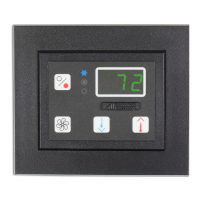Automated Factory Self-Test Program Passport I/O Control Operations Manual
16 L-2231 ENGLISH
2. Use chemical-resistant hoses (white PVC 5/8" I.D., etc.) to connect the inlet of the condenser coil to the outlet of a
chemical resistant, submersible pump (P-500 pump, etc.) and let the hose connected to the coil outlet flow freely into
the container mentioned below.
3. Place a strainer or piece of screen over the inlet of the pump and submerse the pump into a container filled with a 5%
solution of muriatic or hydrochloric acid and fresh water or use a premixed over-the-counter solution. Use as large a
container as possible to hold the solution (5-25 gallons [19-95 liters]).
4. Power the pump and circulate the solution through the condenser coil for 15-45 minutes depending upon the size of
the coils and the extent of the contamination. Visual inspection of the solution in the container should indicate when the
contamination removal has stopped.
5. Circulate fresh water through the coil to flush any residual acid from the system.
6. Restart the system and check operational parameters to ensure thorough cleaning has taken place. Additional
cleaning may be necessary with extreme contamination.
RETURN-AIR FILTER
Check the return-air filter about once a month and clean as necessary. To clean the filter, remove it from the unit, rinse with
water, air dry and reinstall.
WINTERIZATION
There are several methods of winterization, some of which work better than others. Any method that causes the antifreeze
solution to flow downward is the method of choice. By this means, the antifreeze solution displaces any trapped water and
eliminates the possibility of it freezing in hidden areas.
Choose the method that works best for you. In the following four methods, the first two use a 50/50 nonpolluting biodegradable
antifreeze/water solution:
• Pump antifreeze solution into the overboard thru-hull fitting, and discharge through the intake thru-hull fitting.
• Use the seawater pump to pump antifreeze solution through the system and discharge through the overboard thru-hull
fitting: Close seacock, remove hose from strainer discharge, raise hose above pump (so pump does not lose its prime)
and pour in antifreeze solution. Pump solution through system. The strainer and hose to seacock need to be drained of
water.
• Use pressurized air injected at the overboard discharge fitting to force system water through the seawater intake fitting,
thus expelling any trapped water from the system.
• Use pressurized air injected at the seawater intake fitting to force system water through the seawater overboard
discharge fitting, thus expelling any trapped water from the system.
In addition, since the seawater pump utilizes a magnetically driven impeller, remove the impeller from the wet-end assembly,
wipe with an alcohol solution, and store in a warm, dry area until commissioning takes place.
AUTOMATED FACTORY SELF-TEST PROGRAM
The Passport I/O software contains a self-test program to facilitate factory testing of the entire air conditioning system. Once the
self-test program is activated, the test cycle continues until the AC power is interrupted or the Power button is pressed once,
which returns the system to Off Mode.
To activate the self-test program, disconnect the AC power, then press and hold the Power button while restoring the AC
power. During Power-On Reset (the display indicates “888” and all LEDs are lit), release the Power button. The control is now in
the self-test program and “tSt” appears in the display.
Once activated, the self-test software continuously executes the following commands:
CAUTION
Avoid spilling or splashing the solution. Follow all warnings and recommendations given by the manufacturer of any
acids or premixed solutions.
NOTE
For the purpose of protecting the environment, dispose of any contaminated acid solutions in accordance with
federal, state and/or local regulations.
NOTE
Collect all discharged liquids and recycle or dispose of in a proper manner in accordance with federal, state and/or
local regulations.

